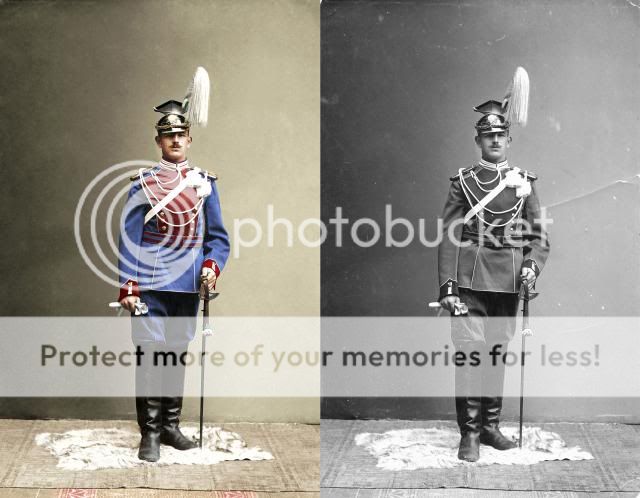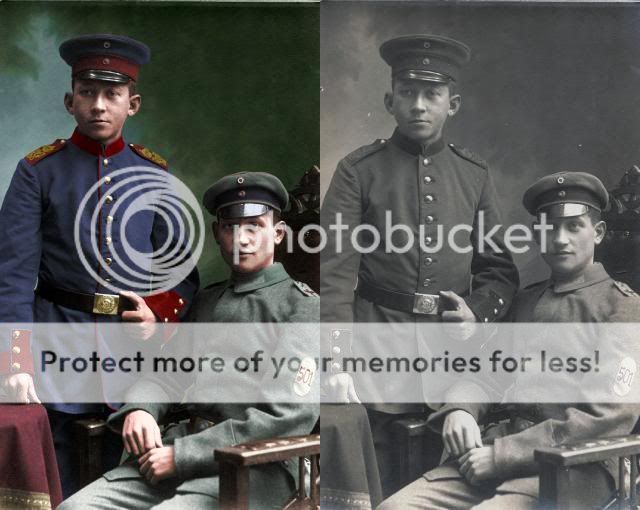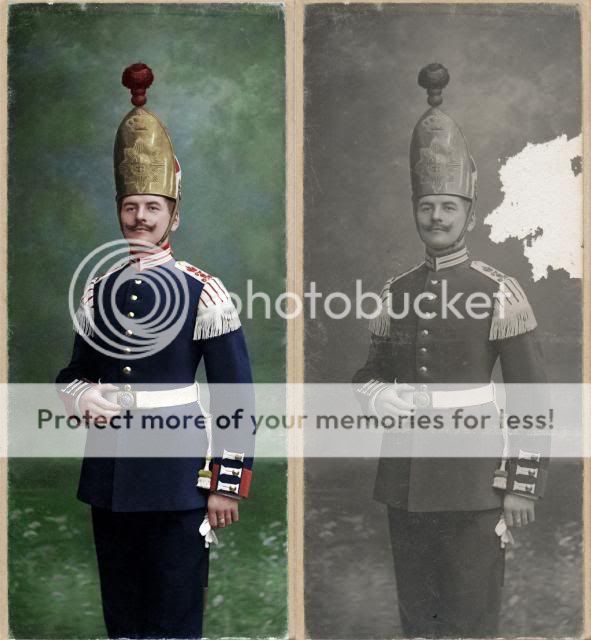Paranoid_Womb
New member
I would like to share with you guys a little project of me and Rui, which involved the restauration and colorization of period original military photography (Imperial Germany).
I just deliver the pictures and part of the info, so all credit for this time-consuming task goes to Rui, who does further research and makes the portraits come to life again. We of course aim to get it as historically correct as possible, as anyone here should be able to appreciate. As I can't rely on my knowlegde, or info on the internet and books alone, we have had help from Marshall V Daut, Tony Schnurr, Brett Butterworth, Thomas Wiktor and Glenn RJ already. Again, much gratitude gentlemen!!!
For the next weeks weeks, I will upload one side by side each week, this in a chronological order as we made/make them. I hope you'll enjoy them.
The first one is a Saxon Ulahn in parade dress:

Some info:
The Tschapka helmet with Feldzeichen features a silver Saxon wappen on a gilt star with gilt chinscales. Note that the helmet is one with parade accountrements, namely the haarbusch and a coloured fabric on the base of the top. On his blue Ulanka with gilt epaulettes featuring their regimental cypher, he's also wearing a Parade-rabbat, an additional section on the chest of this double breasted tunic. The rabbat is in red, as well as the Polish cuffs. He's also wearing a special belt in blue and red, worn by enlisted men during parades. Given the white litzen on the collar and cuffs, he can only be from the Kgl. Sächs. (Royal Saxon) 1. Ulanen-Regt. Kaiser Franz Josef von Österreich, König von Ungarn'' Nr.17. He brougth his Kavalleriedegen 1889 with him and the military issue Faustriemen is nicely visible. On his chest/shoulders is the Ulanenfangschnurr (normally attached to the helmet as well, to secure the helmet to the tunic, so they couldn't lose it during combat) and the Mannschaftbandelier to carry the cavalry ammo pouch.
More period original photography can be found on my photostream:
http://www.flickr.com/photos/paranoid_womb/" onclick="window.open(this.href);return false;
I just deliver the pictures and part of the info, so all credit for this time-consuming task goes to Rui, who does further research and makes the portraits come to life again. We of course aim to get it as historically correct as possible, as anyone here should be able to appreciate. As I can't rely on my knowlegde, or info on the internet and books alone, we have had help from Marshall V Daut, Tony Schnurr, Brett Butterworth, Thomas Wiktor and Glenn RJ already. Again, much gratitude gentlemen!!!
For the next weeks weeks, I will upload one side by side each week, this in a chronological order as we made/make them. I hope you'll enjoy them.
The first one is a Saxon Ulahn in parade dress:

Some info:
The Tschapka helmet with Feldzeichen features a silver Saxon wappen on a gilt star with gilt chinscales. Note that the helmet is one with parade accountrements, namely the haarbusch and a coloured fabric on the base of the top. On his blue Ulanka with gilt epaulettes featuring their regimental cypher, he's also wearing a Parade-rabbat, an additional section on the chest of this double breasted tunic. The rabbat is in red, as well as the Polish cuffs. He's also wearing a special belt in blue and red, worn by enlisted men during parades. Given the white litzen on the collar and cuffs, he can only be from the Kgl. Sächs. (Royal Saxon) 1. Ulanen-Regt. Kaiser Franz Josef von Österreich, König von Ungarn'' Nr.17. He brougth his Kavalleriedegen 1889 with him and the military issue Faustriemen is nicely visible. On his chest/shoulders is the Ulanenfangschnurr (normally attached to the helmet as well, to secure the helmet to the tunic, so they couldn't lose it during combat) and the Mannschaftbandelier to carry the cavalry ammo pouch.
More period original photography can be found on my photostream:
http://www.flickr.com/photos/paranoid_womb/" onclick="window.open(this.href);return false;


